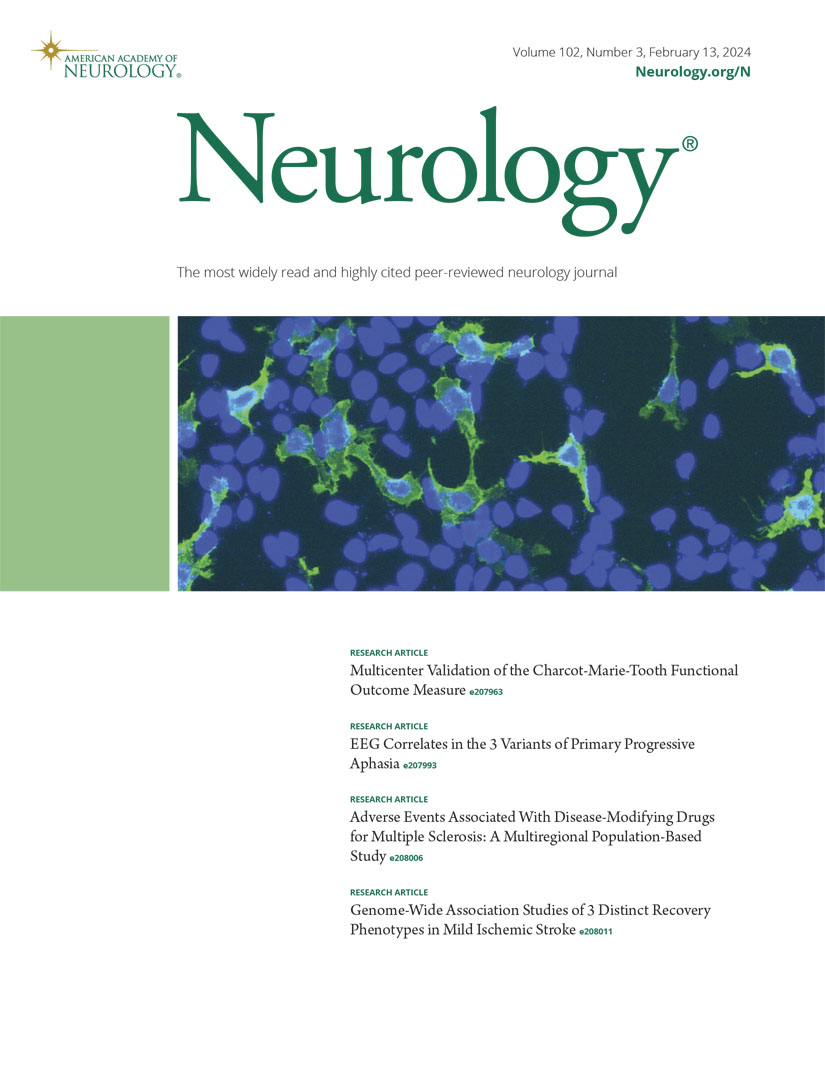adcy5相关的运动障碍:来自长期误诊的耐药癫痫。
IF 7.7
1区 医学
Q1 CLINICAL NEUROLOGY
引用次数: 0
摘要
ADCY5相关运动障碍(ADCY5- rd)是一种儿童期发病的多动运动障碍,由ADCY5基因的致病变异引起。与睡眠和/或觉醒有关的运动和运动的阵发性恶化是ADCY5-RD的标志。因此,ADCY5-RD经常被误诊为睡眠相关的多动症、睡眠障碍、阵发性运动亢进、儿童期舞蹈病或心因性事件。在本病例中,一名长期被误诊为耐药癫痫的59岁妇女,通过视频脑电图最终被诊断为ADCY5-RD。自2岁起,她一直被随访,主要发生在睡眠期间的阵发性不自主运动。她还表现出持续进行性构音障碍和轴性张力低下。发作性口面肌张力障碍也存在。57年来,这些症状一直在用各种抗癫痫药物组合治疗。然而,当长时间的视频脑电图监测记录了从NREM睡眠的N1和N2阶段开始的睡眠性非癫痫性事件时,诊断被重新考虑。ADCY5基因检测证实了诊断。咖啡因和除氯硝西泮外的抗癫痫药物的逐渐停药导致发作的临床改善,发作变得不那么强烈和频繁。鉴于ADCY5-RD于2012年首次被描述,可能有更多的成人患者在儿童期被误诊。因此,我们建议对患有阵发性睡眠相关事件的成人患者考虑替代诊断,以检测成人ADCY5-RD。尽管ADCY5-RD仍然没有治疗指南,腺苷- 2a受体拮抗剂已经成为一种有希望的治疗选择。本文章由计算机程序翻译,如有差异,请以英文原文为准。
Pearls & Oy-sters: ADCY5-Related Dyskinesia: From a Longstanding Misdiagnosis of Drug-Resistant Epilepsy.
ADCY5-related dyskinesia (ADCY5-RD) is a hyperkinetic movement disorder of childhood onset, resulting from pathogenic variants in the ADCY5 gene. Paroxysmal worsening of the movements and movements that occur in relation to sleep and/or awakenings are hallmarks of ADCY5-RD. ADCY5-RD is therefore often misdiagnosed as sleep-related hypermotor epilepsy, sleep disorders, paroxysmal hyperkinesias, childhood onset chorea, or psychogenic events. In this case, a 59 year-old woman with a longstanding misdiagnosis of drug-resistant epilepsy was ultimately diagnosed with ADCY5-RD following video EEG. She had been followed for paroxysmal episodes of nonvoluntary movements mostly occurring during sleep since 2 years of age. She also exhibited continuous progressive dysarthria and axial hypotonia. Episodic orofacial dystonia was present as well. For 57 years, these symptoms had been treated with various combinations of antiseizure medications. However, the diagnosis was reconsidered when prolonged video-EEG monitoring recorded sleep-onset nonepileptic events, starting during N1 and N2 stages of NREM sleep. Genetic testing of ADCY5 confirmed the diagnosis. Caffeine and progressive withdrawal of antiseizure medications except clonazepam resulted in clinical improvement in paroxysms, which became less intense and less frequent. Given that ADCY5-RD was first described in 2012, there may be more adult patients misdiagnosed in childhood. Thus, we recommend considering alternative diagnosis for adult patients with paroxysmal sleep-related events to detect ADCY5-RD in adults. Although there are still no treatment guidelines for ADCY5-RD, adenosine-2A receptor antagonists have emerged as a promising therapeutic option.
求助全文
通过发布文献求助,成功后即可免费获取论文全文。
去求助
来源期刊

Neurology
医学-临床神经学
CiteScore
12.20
自引率
4.00%
发文量
1973
审稿时长
2-3 weeks
期刊介绍:
Neurology, the official journal of the American Academy of Neurology, aspires to be the premier peer-reviewed journal for clinical neurology research. Its mission is to publish exceptional peer-reviewed original research articles, editorials, and reviews to improve patient care, education, clinical research, and professionalism in neurology.
As the leading clinical neurology journal worldwide, Neurology targets physicians specializing in nervous system diseases and conditions. It aims to advance the field by presenting new basic and clinical research that influences neurological practice. The journal is a leading source of cutting-edge, peer-reviewed information for the neurology community worldwide. Editorial content includes Research, Clinical/Scientific Notes, Views, Historical Neurology, NeuroImages, Humanities, Letters, and position papers from the American Academy of Neurology. The online version is considered the definitive version, encompassing all available content.
Neurology is indexed in prestigious databases such as MEDLINE/PubMed, Embase, Scopus, Biological Abstracts®, PsycINFO®, Current Contents®, Web of Science®, CrossRef, and Google Scholar.
 求助内容:
求助内容: 应助结果提醒方式:
应助结果提醒方式:


